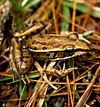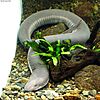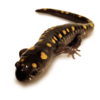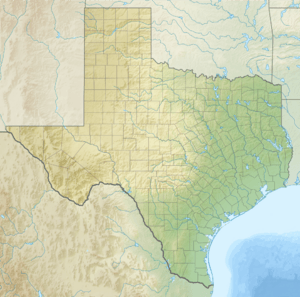List of amphibians of Texas facts for kids
Texas is a huge state with many different kinds of places, from wet swamps to dry deserts and rocky hills. This means it's a perfect home for many different animals, especially amphibians! In Texas, you can find 72 different kinds of amphibians. This includes 44 types of frogs and 28 types of salamanders.
Some of these amazing creatures need special protection. Four species are considered endangered by a big international group called the International Union for Conservation of Nature. These are the Barton Springs salamander, the Texas blind salamander, the black-spotted newt, and the Houston toad. Texas law also protects many native amphibians, with 11 species listed as threatened and four others as endangered within the state.
Texas has many different habitats for amphibians. In the east, you'll find swamps and thick Piney Woods. Central Texas has rocky hills and limestone caves in the Hill Country. The south and west have deserts, and the far west has mountains in the Trans-Pecos area. Up north, there are wide grasslands called the Panhandle. All these different environments make Texas a great place for many types of amphibians and reptiles.
The state's many rivers, like the Rio Grande, the Colorado River, and the Trinity River, also create lots of watery homes. Because Texas is in the middle of the United States, animals from both the western and eastern parts of the country often meet here. Also, since Texas is close to Mexico, many species from Mexico and Central America also live here. The special karst landscape in central Texas has created unique spring and cave homes for some animals found nowhere else, like the endemic Texas blind salamander that lives in caves.
Contents
Amphibian Species in Texas
This list shows the different amphibians found in Texas. Some have special protection under Texas law:
| Threatened (needs protection to avoid becoming endangered) | |
| Endangered (at high risk of disappearing forever) |
Frogs and Toads (Order Anura)
Frogs and toads are amphibians known for their jumping ability and loud calls.
True Toads (Family Bufonidae)
Bufonidae is a family of toads, often called "true toads." Many of them have dry, warty skin and short front and back legs. They also have strong skin toxins, sometimes stored in glands behind their eyes called parotoid glands. These toxins help protect them from predators.
| Species | Common name | Where they live | Status | Image |
|---|---|---|---|---|
| Anaxyrus americanus | American toad | Found in northeast Texas. |  |
|
| Anaxyrus cognatus | Great Plains toad | Lives in wet areas called playa wetlands in the Great Plains part of Texas. |  |
|
| Anaxyrus debilis | Green toad | Found in eastern Texas. |  |
|
| Anaxyrus houstonensis | Houston toad | Lives in southeast Texas counties like Austin, Bastrop, and Lee. |  |
|
| Anaxyrus punctatus | Red-spotted toad | Found in central and western Texas. |  |
|
| Anaxyrus speciosus | Texas toad | Common in the western two-thirds of Texas, but its numbers are going down in the Rio Grande Valley. |  |
|
| Anaxyrus woodhousii | Woodhouse's toad | Found in central, west, and north Texas. |  |
|
| Incilius nebulifer | Coastal plains toad | Lives along the coastal plains. It used to be thought of as the same species as Incilius valliceps. |  |
|
| Rhinella marina | Cane toad | Originally from the very southern tip of Texas. It's an invasive species in other parts of the United States. |  |
Tree Frogs (Family Hylidae)
Hylidae is a family of frogs often called tree frogs. They are commonly found in the Americas. Many have special pads on their toes that help them climb trees and other surfaces.
| Species | Common name | Where they live | Status | Image |
|---|---|---|---|---|
| Acris blanchardi | Blanchard's cricket frog | Found all over Texas, except for the far west and the Panhandle. |  |
|
| Acris crepitans | Northern cricket frog | Found as far west as western Texas. |  |
|
| Dryophytes arenicolor | Canyon tree frog | Lives in separate groups in dry areas and along streambanks in Texas. |  |
|
| Dryophytes chrysoscelis | Cope's gray tree frog | Found in east-central Texas. |  |
|
| Dryophytes cinereus | Green tree frog | Lives throughout eastern Texas and as far south as the Rio Grande Valley. |  |
|
| Hyla squirella | Squirrel tree frog | Found in eastern Texas. |  |
|
| Dryophytes versicolor | Gray tree frog | Lives in the eastern-central part of the state, but not the very easternmost fifth. |  |
|
| Pseudacris clarkii | Spotted chorus frog | Found in central Texas. | ||
| Pseudacris crucifer | Spring peeper | Found in eastern Texas. |  |
|
| Pseudacris fouquettei | Cajun chorus frog | Found throughout eastern Texas. |  |
|
| Pseudacris streckeri | Strecker's chorus frog | Found throughout eastern Texas. |  |
|
| Smilisca baudinii | Mexican tree frog | Lives in the very southern tip of Texas. |  |
New World Frogs (Family Leptodactylidae)
Leptodactylidae is a family of frogs found only in the Americas. Texas is part of their northernmost range. These are medium to large frogs with strong back legs that help them jump far.
| Species | Common name | Where they live | Status | Image |
|---|---|---|---|---|
| Craugastor augusti | Eastern barking frog | Found in western and central Texas, and along the Balcones Fault. Some groups also live in the Trans-Pecos region. |  |
|
| Eleutherodactylus cystignathoides | Rio Grande chirping frog | Native to the very southern part of Texas, along the lower Rio Grande Valley in Cameron and Hildago counties. |  |
|
| Eleutherodactylus guttilatus | Spotted chirping frog | Found in the Big Bend region. |  |
|
| Eleutherodactylus marnockii | Cliff chirping frog | Common in rocky areas of central Texas. |  |
|
| Eleutherodactylus planirostris | Greenhouse frog | An Introduced species found on Galveston Island. |  |
|
| Leptodactylus fragilis | Mexican white-lipped frog | Found in the very southern part of the lower Rio Grande Valley. |  |
Narrow-mouthed Frogs (Family Microhylidae)
Microhylidae is a family of frogs often called "narrow-mouthed frogs" because of their tear-dropped shape.
| Species | Common name | Where they live | Status | Image |
|---|---|---|---|---|
| Gastrophryne carolinensis | Eastern narrowmouth frog | Found as far west as central Texas. |  |
|
| Gastrophryne olivacea | Great Plains narrowmouth frog | Found all over Texas, except for the northern Panhandle and the very western edges. |  |
|
| Hypopachus variolosus | Mexican narrow-mouthed frog | Found in 15 counties in southern Texas. |  |
True Frogs (Family Ranidae)
Ranidae, or true frogs, are the largest family of frogs. Members of this family usually have strong back legs, webbed toes, and an aquatic tadpole stage.
| Species | Common name | Where they live | Status | Image |
|---|---|---|---|---|
| Lithobates areolatus | Crawfish frog | Once found all over eastern Texas, now only in two groups near the coast. |  |
|
| Lithobates berlandieri | Rio Grande leopard frog | Lives in central and western parts of the state. |  |
|
| Lithobates blairi | Plains leopard frog | Found in northern Texas. |  |
|
| Lithobates catesbeianus | Bullfrog | Lives throughout most of Texas. |  |
|
| Lithobates clamitans | Green frog | Found throughout eastern Texas. |  |
|
| Lithobates grylio | Pig frog | Lives in Galveston Bay and the Gulf Coastal Plain to the east. |  |
|
| Lithobates palustris | Pickerel frog | Found throughout eastern Texas. |  |
|
| Lithobates sphenocephala | Southern leopard frog | Common in the eastern third of Texas. |  |
Mexican Burrowing Toads (Family Rhinophrynidae)
Rhinophrynidae is a family of frogs with only one living type, the Rhinophrynus. This frog digs underground and eats ants and termites, which is why it's called the "burrowing frog."
| Species | Common name | Where they live | Status | Image |
|---|---|---|---|---|
| Rhinophrynus dorsalis | Mexican burrowing toad | Found in Starr and Zapata counties in very southwestern Texas. |  |
Spadefoot Toads (Family Scaphiopodidae)
Scaphiopodidae are a family of frogs often called spadefoot toads. They usually have dull colors. Most of these frogs live underground until it rains. To help them dig, they have hard, shovel-like bumps on their feet.
| Species | Common name | Where they live | Status | Image |
|---|---|---|---|---|
| Scaphiopus couchii | Couch's spadefoot toad | Lives in central Texas. |  |
|
| Scaphiopus hurterii | Hurter's spadefoot toad | Lives in freshwater areas of Texan forests, shrublands, grasslands, and wetlands. |  |
|
| Spea bombifrons | Plains spadefoot toad | Found in the dry plains of northwest Texas. Some groups also live in south Texas. |  |
|
| Spea multiplicata | New Mexico spadefoot toad | Found in central Texas. |  |
Salamanders (Order Urodela)
Salamanders are amphibians that look a bit like lizards, but they have smooth, moist skin and usually live near water.
Amphiumas (Family Amphiumidae)
Amphiumidae is a family of salamanders called amphiumas. These large salamanders are often mistaken for eels because of their long, snake-like bodies. They live completely in water and can survive droughts by making a slimy cocoon underground. They can live without food for up to three years and might live for almost 30 years!
| Species | Common name | Where they live | Status | Image |
|---|---|---|---|---|
| Amphiuma tridactylum | Three-toed amphiuma | Native to the eastern part of Texas. |  |
Newts and True Salamanders (Family Salamandridae)
Salamandridae is a family of salamanders. Most members, called salamandrids, make a strong toxin in their skin. They often have bright, contrasting colors to warn predators that they are poisonous. They have four well-developed legs.
| Species | Common name | Where they live | Status | Image |
|---|---|---|---|---|
| Notophthalmus meridionalis | Black-spotted newt | Found in southern Texas. |  |
|
| Notophthalmus viridescens | Eastern newt | Native to eastern Texas. |  |
Mole Salamanders (Family Ambystomatidae)
Ambystomatidae is a family of salamanders that mostly live on land. They are often called "mole salamanders" because most of them live in burrows made by rodents. They only come out on rainy nights to find mates and food. These fairly large salamanders also tend to travel in big groups to ponds for mating.
| Species | Common name | Where they live | Status | Image |
|---|---|---|---|---|
| Ambystoma maculatum | Spotted salamander | Found near still water in hardwood and mixed forests. |  |
|
| Ambystoma mavortium | Barred tiger salamander | Lives all over Texas except the eastern quarter. |  |
|
| Ambystoma opacum | Marbled salamander | Found throughout East Texas, from the Red River south to the Gulf of Mexico. |  |
|
| Ambystoma talpoideum | Mole salamander | Found in the Gulf Coastal Plain of east Texas. | ||
| Ambystoma texanum | Smallmouth salamander | Lives in eastern Texas. |  |
|
| Ambystoma tigrinum | Eastern tiger salamander | Lives all over Texas except the eastern quarter. |  |
Lungless Salamanders (Family Plethodontidae)
Plethodontidae is the largest group of salamanders. Most of them are found in the Americas, but some live in Southern Europe and South Korea. Several types of salamanders in Texas live only in specific cave systems. Because their homes are so small and special, many of them are threatened or endangered. In 2019, scientists from the University of Texas Austin and Texas Parks and Wildlife announced they found three more new species of spring and cave salamanders in the Eurycea group that haven't been named yet!
| Species | Common name | Where they live | Status | Image |
|---|---|---|---|---|
| Desmognathus auriculatus | Southern dusky salamander | Found as far east as the Trinity River Basin. |  |
|
| Eurycea latitans | Cascade Caverns salamander | Lives only in the Cascade Caverns of central Texas and nearby cave systems. | ||
| Eurycea nana | San Marcos salamander | Found only in the San Marcos River in Hays County. |  |
|
| Eurycea naufragia | Georgetown salamander | Lives only in the area northeast of the Colorado River in the Edwards Plateau region of central Texas. |  |
|
| Eurycea neotenes | Texas salamander | Lives in spring and cave systems in the Edwards Plateau region of central Texas. | ||
| Eurycea quadridigitata | Dwarf salamander | Found in eastern Texas. |  |
|
| Eurycea rathbuni | Texas blind salamander | Only lives in water-filled caves in the Edwards Plateau in Hays County. |  |
|
| Eurycea robusta | Blanco blind salamander | Its exact home is unknown; only one was found in an underground system under the Blanco River in Hays County. | ||
| Eurycea chisholmensis | Salado Springs salamander | Lives only in the area northeast of the Colorado River in the Edwards Plateau region of central Texas. | ||
| Eurycea sosorum | Barton Springs salamander | Found only at the outlets of Barton Springs in Zilker Park, Austin. |  |
|
| Eurycea tonkawae | Jollyville Plateau salamander | Lives only in the Buttercup Cave system near Austin. |  |
|
| Eurycea tridentifera | Comal blind salamander | Lives only in Honey Creek Cave in Comal County and other caves in the Cibolo Sinkhole Plain. | ||
| Eurycea troglodytes | Valdina Farms salamander | Lives only in springs and cave systems in counties like Bandera, Edwards, and Medina. | ||
| Eurycea waterlooensis | Austin blind salamander | Known only from the outflows of Barton Springs in Austin. | ||
| Eurycea pterophila | Fern bank salamander | This species lives in springs within the watershed of the Blanco River. | ||
| Plethodon albagula | Western slimy salamander | Found in separate groups in central, southeastern, and northeastern Texas. |  |
|
| Plethodon serratus | Southern red-backed salamander | While found in other parts of the southeastern US, only one has ever been found in Texas, in Nacogdoches County in 1940. |  |
Sirens (Family Sirenidae)
Sirenidae is a family of salamanders that live only in water. They are found in northern Mexico and the Southeastern United States. Sirens have very small front legs and no back legs at all. They are thought to be the most ancient living salamanders.
| Species | Common name | Where they live | Status | Image |
|---|---|---|---|---|
| Siren intermedia nettingi | Western lesser siren | Found in east and southeast Texas, as well as in the Rio Grande Valley. |  |
|
| Siren intermedia texana | Rio Grande lesser siren | Lives in south Texas. |
Mudpuppies and Waterdogs (Family Proteidae)
Proteidae is a family of salamanders that live only in water. They are found in North America and Europe. Some members are called mudpuppies or waterdogs. They keep their larval features, like red, feathery external gills, even as adults. Only one species from this family is found in Texas.
| Species | Common name | Where they live | Status | Image |
|---|---|---|---|---|
| Necturus beyeri | Gulf Coast waterdog | Found in the Sabine River System. |  |
See also


